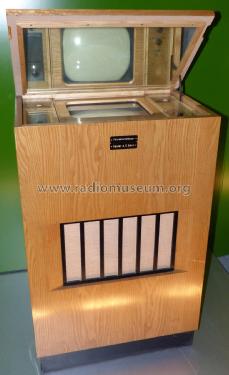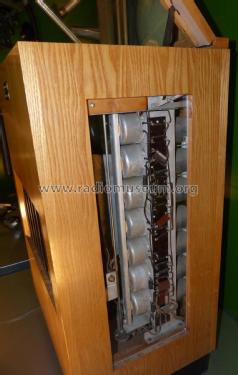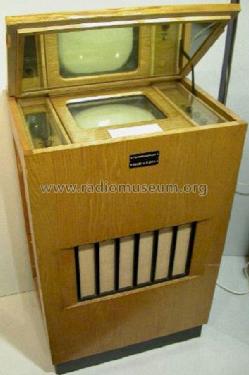Landi
Hasler AG; Bern
- Hersteller / Marke
- Hasler AG; Bern
- Jahr
- 1939
- Kategorie
- Fernseh-Empfänger/Monitor
- Radiomuseum.org ID
- 200601
- Wellenbereiche
- VHF/UHF (siehe Bemerkungen)
- Betriebsart / Volt
- Netzstrom-Gerät (Art nicht bekannt)
- Lautsprecher
- Dynamischer LS, Prinzip (Edyn oder Pdyn) nicht gegeben.
- Material
- Gerät mit Holzgehäuse
- von Radiomuseum.org
- Modell: Landi - Hasler AG; Bern
- Form
- Standgerät: allgemein.
- Abmessungen (BHT)
- 615 x 1250 x 438 mm / 24.2 x 49.2 x 17.2 inch
- Bemerkung
- Hasler "Landi";
s/w Fernsehempfänger, Bildröhre stehend mit Umlenkspiegel, hergestellt als Machbarkeitsstudie, keine Fertigung aufgrund fehlender Normen und Marktunsicherheit.
- Literaturnachweis
- Ausgestellt im Museum für Kommunikation, Bern, Schweiz 9808.553-115-1
- Autor
- Modellseite von einem Mitglied aus A angelegt. Siehe bei "Änderungsvorschlag" für weitere Mitarbeit.
- Weitere Modelle
-
Hier finden Sie 23 Modelle, davon 22 mit Bildern und 5 mit Schaltbildern.
Alle gelisteten Radios usw. von Hasler AG; Bern
Forumsbeiträge zum Modell: Hasler AG; Bern: Landi
Threads: 1 | Posts: 1
Physics Professor Doctor Franz Tank of the Eidgenössische Technische Hochschule (ETH) constructed a television demonstration for the 1939 Swiss National Exhibition known as the "Landi". This included a complete television studio for the transmision of films and a number of prototype television receivers. Among these receivers was one created by the Hasler company which used the same circuitry as the Marconiphone 702 and HMV 901 manufactured by the EMI company in the UK.
It is not known why Hasler did not simply offer one of the EMI products directly for the Landi exhibition. It is known that EMI had difficulty fulfilling the demand for television receivers at that time and this might explain why the Hasler receiver for Landi appears to have been constructed using EMI valves, cathode ray tube and chassis but with circuitry built using locally sourced components and a locally constructed cabinet.
The following article by Prof. Franz Tank describes the television studio displayed at the Landi exhibition and is reproduced by kind permission of Museum für Kommunikation, Bern.
Apart from the Hasler receiver ETH displayed the receiver shown here.
Grateful thanks to Thomas Günzel for converting the original document to machine readable format.
Anlagen
Peter Scott, 10.Apr.17




